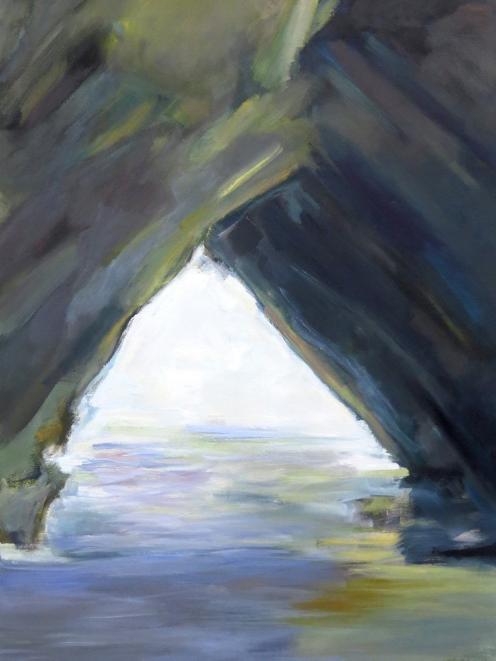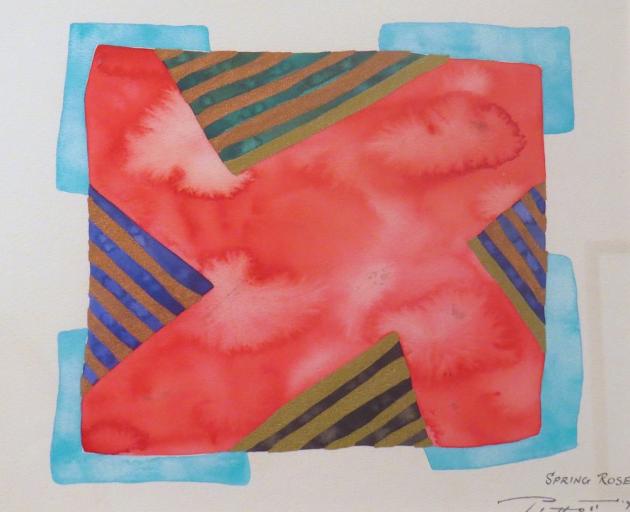This week in Art Seen, James Dignan looks at exhibitions by Angela Burns, Faith Wilson, and Rob Piggott.
 High Tide, by Angela Burns
‘‘Colours of Silence’’, Angela Burns (Moray Gallery)
High Tide, by Angela Burns
‘‘Colours of Silence’’, Angela Burns (Moray Gallery)

Angela Burns' latest exhibition, the nicely titled ''Colours of Silence'', is a continuation of her previous work yet also a radical step away from abstraction towards realistic representation.
Burns is perhaps best known for her subtle, haunting visual tone poems, with strands of colour flowing and interweaving across the picture plane. These works have always suggested the sensation of light playing on the surface of moving water, but have never made their subject explicit.
In ''Colours of Silence'', however, we see Burns's inspiration directly. The caves and rock formations along the coast to the east of Waitati come into strong yet flowing focus. With bold impressionistic strokes, the geology of Doctor's Point comes into glorious life. The interplay of sunlit and shaded beach, waves and rock is transformed into a series of primal elements boldly marked with gestural strokes of earthy colour.
Several of Burns's abstract works are on display, yet the liquid horizontals of Late Summer Sea and Blueskin at Dusk now reveal themselves to be the waters and evening light previously only imagined, and these works throw the solidity of the more representational works into powerful focus.
The exhibition is complemented by a display of photographs of the artist's subject landforms, and of her preparatory watercolour sketches.
 Confessions of a Teenage Afakasi (detail), by Faith Wilson
‘‘Confessions of a Teenage Afakasi’’, Faith Wilson (Blue Oyster Gallery)
Confessions of a Teenage Afakasi (detail), by Faith Wilson
‘‘Confessions of a Teenage Afakasi’’, Faith Wilson (Blue Oyster Gallery)

Faith Wilson is afakasi - that is, a person of mixed Samoan-European (Palagi) descent.
The term afakasi - literally, ''half-caste'' - is somewhat perjorative, suggesting there is something wrong in being of mixed birth. Peer pressure, especially during the teenage years, can be vicious, and anyone seen as different can find themselves bullied and, sadly, feeling a lack of self-esteem for failing to meet perceived standards of normality. Wilson faced these stresses and suffered. Shunned for being either too brown or not brown enough, she retreated into rebellion and bulimia.
Now, in an act of restoration and reclamation, the artist has recreated an autobiographical teenage bedroom, littered with emo poetry and pop psychology books, and with walls scrawled with messages of desperation, confession and hope.
Among the messages is a tribute to singer Whitney Houston, and in the gallery's second room we see Wilson as she is now, proud of her body and her person as she mimes to a Houston song. The artist's past and present is summed up by a T-shirt on the room's floor, bearing the simple yet double-edged message ''I wanted you to see me''.
The exhibition is a message to other teenagers past and present: a person can live through a harrowing adolescence and come through not unscarred, but strengthened.
 Spring Rose, by Robert Piggott
‘‘Night’s Edge’’, Robert Piggott (Robert Piggott Gallery)
Spring Rose, by Robert Piggott
‘‘Night’s Edge’’, Robert Piggott (Robert Piggott Gallery)

Rob Piggott's ''Night's Edge'' consists of two abstract series, each exploring the tension and movement provoked by that most powerful of simple forms, the triangle.
The gallery's smaller room contains bright watercolours, each using the flowing nature of the medium to good effect. Solid, hard-edged blocks of colour jostle for attention, yet the areas within each block are softened and blurred, producing a gentleness that complements and plays against the rigidity of the shapes themselves.
The larger works in the main gallery form a second series, ''Daybreak''. These four works in oil-pastel and dye are dynamic area of light invaded from the edges by sharp black triangular forms. The bright centre is somehow trapped and encased, as if caught in mechanical jaws filled with jagged teeth. All the works, especially Dawn Follows the Night and From Night to Day, have strong angular compositions and are deliberately reminiscent of some of Colin McCahon's powerful images.
The similarity extends beyond the composition. As with McCahon, Piggott's work explores the representation of the spiritual coupling of the dark and the light, whether it be the separation of light and darkness in the Christian creation story, the equivalent Maori myth of Rangi and Papa, or the Chinese concept of yin and yang.








![Untitled (c. mid 1990s, [pink 3]), by Martin Thompson, 415mm×590mm. Photo: courtesy of Brett...](https://www.odt.co.nz/sites/default/files/styles/odt_landscape_small_related_stories/public/story/2024/02/untitled_pink_3.jpg?itok=Q0aQrc9o)



